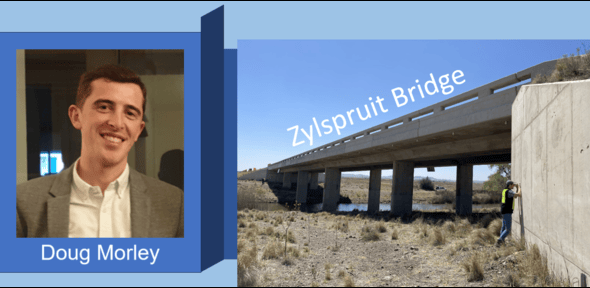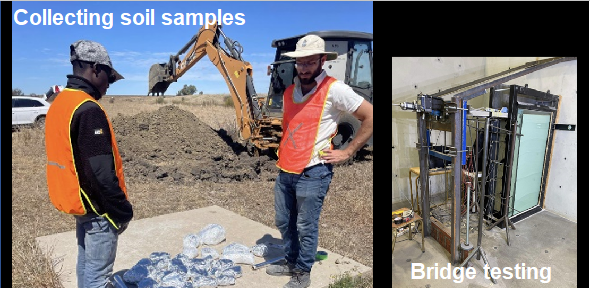
Submitted by Paula Block on Fri, 28/02/2025 - 14:50
Congratulations to Doug Morley from Cohort 2 on his published paper in the Journal of Bridge Engineering. This paper is an outcome of his secondment in South Africa.
"The opportunity to carry out research into integral bridges in South Africa through FIBE2 CDT was fantastic. To conclude this with a publication makes it a valuable contribution to our PhD work." - Doug Morley
Integral bridges are preferred over jointed constructions because they require less maintenance over their lifespan. However, the design process can be challenging due to uncertainties regarding the interaction between the backfill soil and abutments during thermal cycles. South Africa's hot and dry climate significantly affects the extent of thermal movements and concrete drying shrinkage. This study presents over six years of field data from the Van Zylspruit Bridge, a 90-meter-long integral bridge built in 2016 in central South Africa. Located 600 km south of Pretoria, the bridge carries the N1 highway over a river.
Small-scale physical modelling was conducted at the University of Pretoria to investigate the absence of strain ratcheting. Sensors were employed to record temperature, abutment movement, earth pressure, and soil water content, providing insights into bridge behaviour.
By simulating the soil-structure interaction behind an integral bridge, potential explanations such as the possibility of increasing pressures over an extended monitoring period could be explored.
As the bridge deck expands and contracts throughout the year, each abutment pushes into and pulls away from the backfill, leading to an earth pressure buildup known as soil strain ratcheting, along with settlement at the bridge approach. Various mechanisms, including densification, interlocking, and fabric change, are believed to contribute to this pressure increase. These processes are partly driven by soil filling the gap that forms at the backfill-abutment interface during deck contraction phases.
The results indicate only a slight increase in earth pressure over time, which is significantly less than anticipated from physical modelling. One possible explanation for this discrepancy is the smaller-than-expected thermal movements that were recorded. Further possibilities were explored through small-scale modelling of a 1.5-meter RC abutment. The findings indicated that the initial position of the abutment and concrete drying shrinkage are unlikely to contribute to the pressure buildup. However, soil water content may influence the pressure through the suctions generated. Based on these results, the strain ratcheting of earth pressures in the field seems to be less severe than suggested by modelling efforts.
While this research was conducted on a bridge in South Africa, the design temperature range of 46°C aligns closely with that used in other regions, such as the UK, making the findings widely applicable. This research provides a notable contribution to the sparse collection of integral bridge field data that exists.
Doug has done excellent work on his research which also won the Turner prize. See Doug Morley awarded Turner Prize | EPSRC Centre for Doctoral Training in Future Infrastructure and Built Environment: Resilience in a Changing World (FIBE2)


